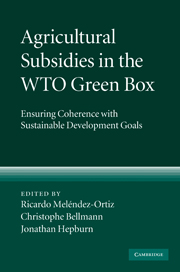Book contents
- Frontmatter
- Contents
- List of contributors
- Preface
- Acknowledgements
- List of abbreviations
- 1 Overview
- PART I The recent evolution of agricultural trade policy reform
- PART II The focus, extent and economic impact of green box subsidies
- PART III Green box subsidies and developing countries
- PART IV Green box subsidies and the environment
- 15 The environmental impact of green box subsidies: exploring the linkages
- 16 The environmental impact of EU green box subsidies
- 17 The environmental impact of US green box subsidies
- 18 Biofuels subsidies and the green box
- PART V Looking forward: how can change take place?
- Appendix: Text of Annex 2 of the WTO Agreement on Agriculture (“the green box”)
- Index
- References
17 - The environmental impact of US green box subsidies
from PART IV - Green box subsidies and the environment
Published online by Cambridge University Press: 03 May 2010
- Frontmatter
- Contents
- List of contributors
- Preface
- Acknowledgements
- List of abbreviations
- 1 Overview
- PART I The recent evolution of agricultural trade policy reform
- PART II The focus, extent and economic impact of green box subsidies
- PART III Green box subsidies and developing countries
- PART IV Green box subsidies and the environment
- 15 The environmental impact of green box subsidies: exploring the linkages
- 16 The environmental impact of EU green box subsidies
- 17 The environmental impact of US green box subsidies
- 18 Biofuels subsidies and the green box
- PART V Looking forward: how can change take place?
- Appendix: Text of Annex 2 of the WTO Agreement on Agriculture (“the green box”)
- Index
- References
Summary
Introduction
This is an effort to focus not on the trade-related features of US green box payments, but on their environmental effects. It is easy to assume that they are benign, since many environmental programs are notified as green box measures. However a closer investigation reveals that this may not always be the case. Even though they are assumed to have no production-enhancing features, some do – and increased production can be harmful to the environment since US agriculture at scale almost always involves cropping systems that deplete soil and water resources and release carbon. Other US green box measures can be equally disruptive to the environment. “Emergency” natural disaster payments can keep producers on marginal lands in business if the payments are as annual as some of the crops they grow. Furthermore environmental programs with the best intentions can reward producers for doing what they would do in any case, even though it is not better than what is normal for the region or the crop.
There are many safeguards in place to ensure that programs are effective and achieve their objectives, but what happens to programs based on market mechanisms when the market rewards poor environmental performance? Finally, what alternatives might be suggested to more closely align green box programs with their intended use? These and other relevant issues are discussed below.
Background
The green box is not green
The “green box” is of course not “green” in the environmental sense.
- Type
- Chapter
- Information
- Agricultural Subsidies in the WTO Green BoxEnsuring Coherence with Sustainable Development Goals, pp. 496 - 529Publisher: Cambridge University PressPrint publication year: 2009



